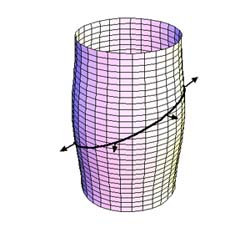(有機導体フェルミ面の磁気光学的研究)
by Yugo Oshima
Version 1.0 (Feb. 14th 2003)


Schematic figures of q2D and q1D Fermi surface
by Yugo Oshima
Version 1.0 (Feb. 14th 2003)


Schematic figures of q2D and q1D Fermi surface
Download (From Dropbox)
Download (From Kobe University Repository)
Download (From hugolab.com): Temporary Unavailable
| Quasi-one-dimensional (q1D) and Quasi-two-dimensional (q2D) organic conductors have attracted remarkable interest, because their physical properties changes drastically with various anions or crystal structure. For this reason, the Fermi surface (FS) topologies of these salts have been studied by various high magnetic field techniques. Shubnikov-de Haas oscillations (SdH), de Haas-van Alphen oscillations (dHvA) and angle dependent magnetoresistance oscillations (ADMRO) are the most commonly used techniques for the FS studies. However, the magnetooptical measurements are another useful techniques which are becoming powerful tools for FS studies. Recent magnetooptical measurements studies have shown that the mechanisms responsible for the resonant absorption are quite different from the well-known conventional cyclotron resonance (CR). And there are several interesting reports of harmonic resonances which are based on a simple FS structure such as the periodic orbit resonance (POR) and q1D POR. Therefore, we have performed magnetooptical measurements of several q2D and q1D organic conductors which have a simple FS structure. This thesis treats these experimental results of the magnetooptical measurements on organic conductors and we show that the CR and POR can be observed for q2D organic conductors, and q1D POR were observed for q1D organic conductors. q2D results have shown that there are selection rules for observing CR and POR, and despite that CR's effective masses neglect the electron-electron interactions (Kohn's theorem), there is a mass enhancement for POR's effective masses . On the other hand, q1D results have shown that q1D POR can obtain valuable value such as Fermi velocity and the Fourier components of the corrugated FS. |